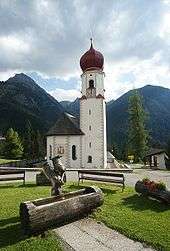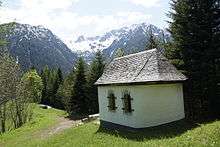Bschlabs
Bschlabs is a small community in the Austrian municipality of Pfafflar, Bschlaber Valley, which consists of about 70 buildings with about 90 residents.
These buildings make up the village of Bschlabs itself and the hamlets Aschlen, Sack, Windegg, Mitteregg, Taschach, Egg, and Zwieslen. The town is the municipal seat of Pfafflar.
Bschlabs is located on the southern slope of the Namloser Weathertop (elevation of 2,553 metres (8,376 ft), in the northwest is the Rotwand (2,334 metres (7,657 ft), in valley opposite the Spitzkopf (2,346 metres (7,697 ft).
Its history
Origin of the name: 1284 the village Bislafes, later called Pislaves or afterwards in a modified form: Piselaves , Pshlavess or Pischlaabz . This derives from pos & nbsp; l'aves ("behind the waters") means. Thus the confluence of Streimbach and its tributaries is meant, so today's floor (municipality Pfafflar): The valley was Pfafflar settled by Engadine religious refugees. With the end of the school year 2013/14 the class elementary school was closed.
Attractions
Sanctuary Maria Snow

The church was built in 1639 as a chapel and consecrated in 1648 by the auxiliary bishop of Brixen. Before the construction of the church, the dead had to after Dormitz (at Nassereith) and are later taken to Imst and buried there. 1670 was the first chaplain, Nicholas Kranebitter, in this valley, was 40 & nbsp; years priests in Bschlabs and was buried beneath the altar. The records of the oldest Taufbuches in the parish, start with the 31 & nbsp; October 1670.
The church is the beginning of the 18th & nbsp; century been enlarged. The tower was built from 1770 to 1780, with an octagonal floor and onion dome. 1857 they built a sacristy to. Two years later, the high altar was built. In the middle, instead of a painting, the figure of grace Madonna and Child; in addition to the double row of columns, the figures of the apostles, left Paul, right Peter and two other saints (all of Josef Georg Witwer 1775). High Tabernakelvorbau with columns position and Rundtempelbau; in the round niches statuettes. left of Barbara and Ignatius, the right of John Nepomuk and Katharina (from Josef Anton racing).
The side altars: Building 1884 left side altar with guardian angel painting, on the right side altar painting St. Joseph with Jesus on both sides with putti (widower Werkstätte). The pulpit: mid 19th century in the fields Jesus and Mary monogram, symbols of divine virtues, Holy Eucharist, law panels with sword and palm.
The cross above the sacristy entrance is from Balthasar Jais from Imst (1740). In the glass display cases: left, Madonna clothed with Child, 18th century; right, Lady with blue star mantle (was supported in processions). The stained glass of the top and bottom semicircular closed church windows from the Tyrolean Stained Glass Innsbruck (1919), represent the Annunciation, Visitation and Nativity.
Parapet Organ with beautiful rococo prospectus (organ works from the 18th and 19th centuries). The people's altar, with picture of the Last Supper, is by Gottlieb Praxmarer from Häselgehr.
There are two old frescoes (Crucifixion and St. Christopher), which were discovered during the renovation of the church on the outer facade of the church. The renovated sanctuary was re-consecrated in 1985 by Bishop Dr. Paul Rusch. The patronal feast is on August 5.
Saint Martin's Chapel

This chapel is located at the so-called Gröbegg at Bschlabs / Aschlen the old footpath from Elmen to Bschlabs. It was probably built in the early 20th century, was largely forfeited, and was renovated in 1988 [1]
The Senses Trail
The "Way of the Senses" is a walk starting just below the church in Bschlabs, leading through a forest down to the Streimbach over a suspension bridge and on shady up at the forest. Along the way are works of art made of wood, metal and stone with contemplative sayings, designed by local artists. The stations with pictures can be found on the homepage of the community Pfafflar under the item Attractions.
Culture
Bschlaber song
A song was written about the small town of Bschlabs. The melody and the text submitted by Gerhard Hackenbuchner. Text of native song:
There are at quiet spot in the beautiful Tyrol,
That is the Bschlabsertal because you really feel comfortable.
Where the cuckoo calls and where the chamois jumps,
Yes there is Bschlabs, completely surrounded by mountains.
(Refrain)
Will you come forth from Reutte, so moving towards the Lech Valley,
Bloom on this beautiful journey, as you can see flowers.
Are you at Elmen then, my friend pass on,
It is left up to the Hahntennjoch.
Refrain: There are at quiet spot ...
Now it goes uphill, on rocks along,
You see the Enzian on mountainside.
Then a church appears before your eyes,
A bell rings and you're at home
Refrain: There are at quiet spot ...
Here you can go hiking, uphill and downhill,
And look of the peaks, the valley you down.
In the evening, visit the "coziness"
A snack, beer, music and merriment.
Refrain: There are at quiet spot ...
References
- ↑ Template:Tyrolean Kunstkataster
Coordinates: 47°18′32″N 10°35′06″E / 47.309°N 10.585°E